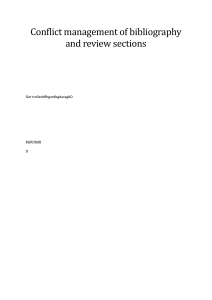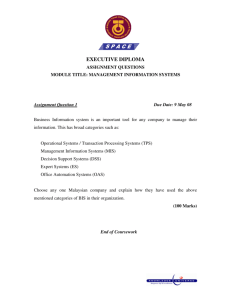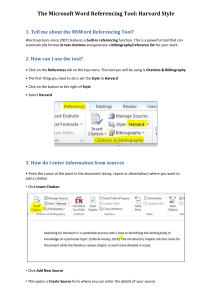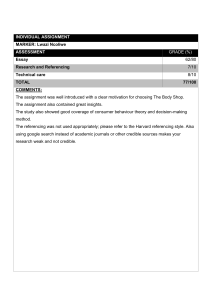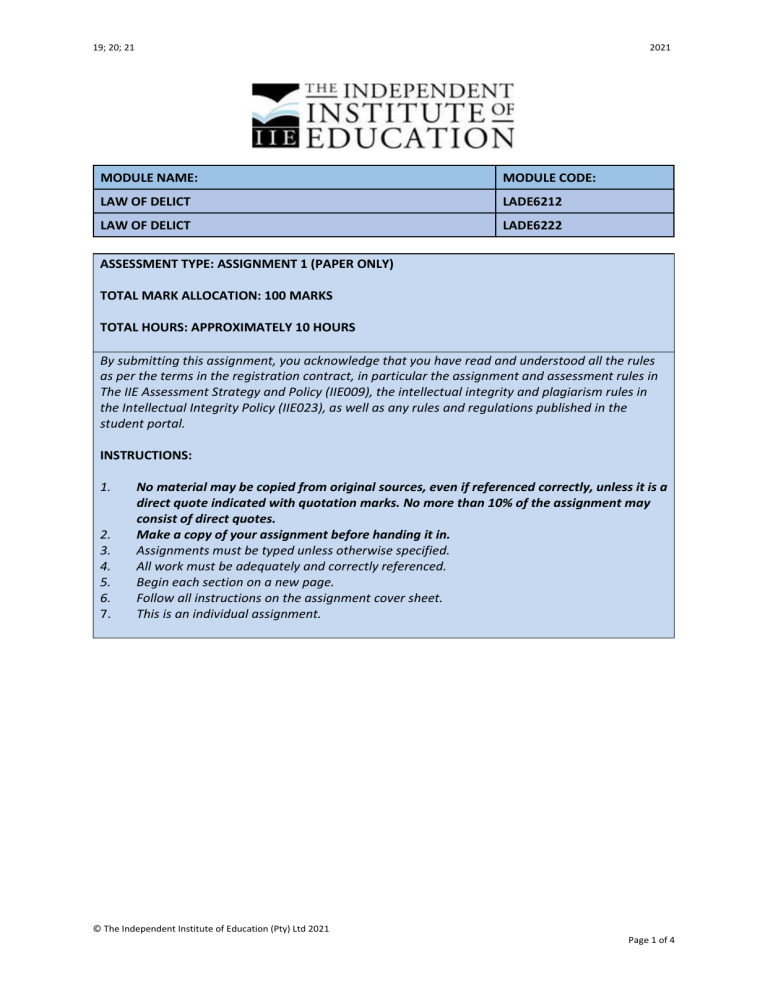
19; 20; 21 2021 MODULE NAME: MODULE CODE: LAW OF DELICT LADE6212 LAW OF DELICT LADE6222 ASSESSMENT TYPE: ASSIGNMENT 1 (PAPER ONLY) TOTAL MARK ALLOCATION: 100 MARKS TOTAL HOURS: APPROXIMATELY 10 HOURS By submitting this assignment, you acknowledge that you have read and understood all the rules as per the terms in the registration contract, in particular the assignment and assessment rules in The IIE Assessment Strategy and Policy (IIE009), the intellectual integrity and plagiarism rules in the Intellectual Integrity Policy (IIE023), as well as any rules and regulations published in the student portal. INSTRUCTIONS: 1. 2. 3. 4. 5. 6. 7. No material may be copied from original sources, even if referenced correctly, unless it is a direct quote indicated with quotation marks. No more than 10% of the assignment may consist of direct quotes. Make a copy of your assignment before handing it in. Assignments must be typed unless otherwise specified. All work must be adequately and correctly referenced. Begin each section on a new page. Follow all instructions on the assignment cover sheet. This is an individual assignment. © The Independent Institute of Education (Pty) Ltd 2021 Page 1 of 4 19; 20; 21 2021 Referencing Rubric - IIE Legal Referencing Guidelines Providing evidence based on valid and referenced academic sources is a fundamental educational principle and the cornerstone of highquality academic work. Hence, The IIE considers it essential to develop the referencing skills of our students in our commitment to achieve high academic standards. Part of achieving these high standards is referencing in a way that is consistent, technically correct and congruent. This is not plagiarism, which is handled differently. Poor quality formatting in your referencing will result in a penalty of a maximum of ten percent being deducted from the percentage awarded, according to the following guidelines. Please note, however, that evidence of plagiarism in the form of copied or uncited work (not referenced), absent reference lists, or exceptionally poor referencing, may result in action being taken in accordance with The IIE’s Intellectual Integrity Policy (0023). Required: Technically correct referencing style Consistency • The same referencing format has been used for all footnote and in the references bibliography/reference list. Technical correctness • Referencing format is technically correct throughout the submission. • Position of the reference: a reference is directly associated with every concept or idea. • For example, quotation marks, page numbers, years, etc. are applied correctly in the footnotes, sources in the bibliography/reference list are correctly presented. Congruence between footnotes and bibliography/ reference list • All sources are accurately reflected and are all accurately included in the bibliography/ reference list. In summary: the recording of references is accurate and complete. Markers are required to provide feedback to students by indicating (circling/underlining) the information that best describes the student’s work. Minor technical referencing errors: 5% deduction from the overall percentage – the student’s work contains five or more errors listed in the minor errors column in the table below. Major technical referencing errors: 10% deduction from the overall percentage – the student’s work contains five or more errors listed in the major errors column in the table below. If both minor and major errors are indicated, then 10% only (and not 5% or 15%) is deducted from the overall percentage. The examples provided below are not exhaustive but are provided to illustrate the error Minor errors in technical correctness of referencing style Deduct 5% from percentage awarded Minor inconsistencies. • The referencing style is generally consistent, but there are one or two changes in the format of footnote referencing and/or in the bibliography. • For example, page numbers for direct quotes (footnote) have been provided for one source, but not in another instance. Two book chapters (bibliography) have been referenced in the bibliography in two different formats. Generally, technically correct with some minor errors. • The correct referencing format has been consistently used, but there are one or two errors. • Concepts and ideas are typically referenced, but a reference is missing from one small section of the work. • Position of the references: references are only given at the beginning or end of every paragraph. • For example, the student has incorrectly presented direct quotes (footnotes) and/or book chapters (bibliography/reference list). Generally, congruence between the footnotes referencing and the bibliography/ reference list with one or two errors. • There is largely a match between the sources presented in-text and the bibliography. • For example, a source appears in the footnotes, but not in the bibliography/ reference list or vice versa. In summary, at least 80% of the sources are correctly reflected and included in a reference list. Major errors in technical correctness of referencing style Deduct 10% from percentage awarded Major inconsistencies. • Poor and inconsistent referencing style used in footnotes and/or in the bibliography/ reference list. • Multiple formats for the same type of referencing have been used. • For example, the format for direct quotes (footnotes) and/or book chapters (bibliography/ reference list) is different across multiple instances. Technically incorrect. • The referencing format is incorrect. • Concepts and ideas are typically referenced, but a reference is missing from small sections of the work. • Position of the references: references are only given at the beginning or end of large sections of work. • For example, incorrect author information is provided, no year of publication is provided, quotation marks and/or page numbers for direct quotes missing, page numbers are provided for paraphrased material, the incorrect punctuation is used (footnotes); the bibliography/reference list is not in alphabetical order, the incorrect format for a book chapter/journal article is used, information is missing e.g. no place of publication had been provided (bibliography); repeated sources on the reference list. A lack of congruence between the footnote referencing and the bibliography. • No relationship/several incongruencies between the footnote referencing and the bibliography/reference list. • For example, sources are included in-text, but not in the bibliography and vice versa, a link, rather than the actual reference is provided in the bibliography. In summary, at least 60% of the sources are incorrectly reflected and/or not included in reference list. Overall Feedback about the consistency, technical correctness and congruence between footnote referencing and bibliography: ...................................................................................................................................................................................................................... © The Independent Institute of Education (Pty) Ltd 2021 Page 2 of 4 19; 20; 21 2021 General Instructions regarding this assignment for students: The questions for this assignment all relate to Stedall and Another v Aspeling and Another 2018 (2) SA 75 (SCA) and a related case, MTO Forestry (Pty) Ltd v Swart NO 2017 (5) SA 76 (SCA). Students are advised to obtain copies of both cases in order to complete this assignment. Question 1 (Marks: 10) In Stedall and Another v Aspeling and Another 2018 (2) SA 75 (SCA) (hereafter Stedall v Aspeling), the court states the following at para 16: “The use of the phrase ‘legal duty’ in these circumstances means no more than that the omission must not be wrongful as judicially determined in the manner referred to above i.e. involving criteria of public and legal policy consistent with constitutional norms - …” Taking into consideration the notion of constitutional norms, discuss the influence of the Bill of Rights on the Law of Delict. In your answer, make reference to the view of the Constitutional Court on developing the common law in the case of Carmichele v Minister of Safety and Security 2001 (4) SA 938 (CC). You will receive more marks for paraphrasing your answer. Question 2 Q.2.1 (Marks: 30) With reference to the judgment of the SCA in Stedall v Aspeling, discuss the (5) ratio decidendi (reasons for decision) of the court a quo in this matter. Q.2.2 The SCA criticises the court a quo for conflating (or blending) wrongfulness with (25) negligence. Analyse this argument by referring also to the case of MTO Forestry (Pty) Ltd v Swart NO 2017 (5) SA 76 (SCA), in particular paras [12] to [17]. © The Independent Institute of Education (Pty) Ltd 2021 Page 3 of 4 19; 20; 21 2021 Question 3 Q.3.1 (Marks: 50) Outline the SCA’s criticism of the respondent’s failure to deal with the (15) requirement of wrongfulness in their particulars of claim and heads of argument. Q.3.2 Discuss the SCA’s argument for distinguishing the following cases relied on by the (15) respondent: • Hirschman NO & Hirschman v Kroonstad Municipality 1914 OPD 37; • Za v Smith & Another 2015 (4) SA 574 (SCA); and • Van Vuuren v eThekwini Municipality [2017] ZASCA 124. In your answer, refer briefly to the relevant facts in each of these cases. Q.3.3 Discuss the SCA’s argument for deciding that wrongfulness is not established. Question 4 (20) (Marks: 10) Q.4.1 Distinguish between the abstract and the concrete approach to foreseeability. (6) Q.4.2 In your opinion, did the SCA in Stedall v Aspeling use the abstract approach or the (4) concrete approach to argue that there was no foreseeability in relation to negligence? Substantiate your answer with reasons. END OF ASSIGNMENT © The Independent Institute of Education (Pty) Ltd 2021 Page 4 of 4
